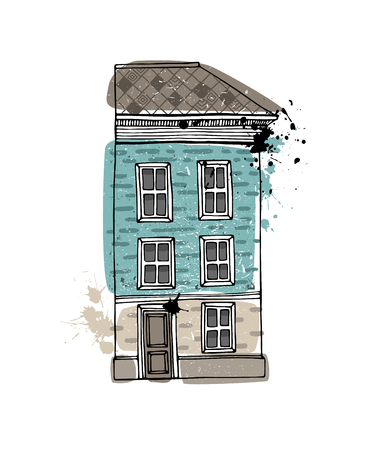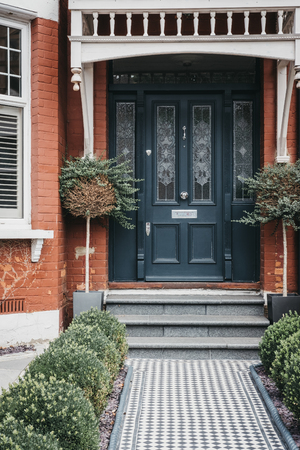Understanding British Home Styles: Victorian, Georgian, and Modern
The character of a British home is often established the moment you approach the front door. From the grand proportions of Georgian terraces to the ornate details of Victorian semis and the clean lines of modern builds, each era brings its own unique style to entryways and hallways. Georgian homes are renowned for their symmetrical façades, classic fanlights above sturdy doors, and wide, welcoming entrance halls adorned with decorative cornices and elegant staircases. In contrast, Victorian houses typically feature striking coloured tiles leading to panelled front doors, stained glass windows, and narrow yet impressively detailed hallways with high skirting boards and original floorboards. Modern British homes favour a more minimalistic approach—think sleek composite doors, energy-efficient glazing, practical flooring like engineered wood or tiles, and open-plan layouts that maximise light and space from the moment you step inside. Each style not only reflects its period’s aesthetic but also shapes how homeowners present their property’s first impression—making the entryway both functional and inviting while capturing the essence of British curb appeal.
First Impressions: The Importance of the Front Door and Exterior Details
The front door is the focal point of any British home’s exterior, setting the tone for what lies within. In both historic and modern settings, a well-maintained door not only improves kerb appeal but also reflects personal style and attention to detail. Whether you’re restoring a Victorian terrace or updating a sleek new-build, classic British features like letterboxes, knockers, and exterior lighting play a significant role in creating a welcoming entrance.
Classic vs Contemporary Styles
Victorian and Georgian homes typically feature solid timber doors painted in rich heritage colours such as deep green, navy blue, or oxblood red. These doors often come with ornate brass or iron knockers, decorative letterplates, and stained-glass panels. Modern homes, by contrast, favour streamlined composite or aluminium doors in neutral shades with minimalist hardware.
| Feature | Victorian/Georgian Style | Modern Style |
|---|---|---|
| Door Material | Solid wood (often panelled) | Composite or aluminium |
| Colour Palette | Heritage colours (deep tones) | Neutral greys, whites, blacks |
| Letterbox Position | Centre of door or lower half | Horizontal slot, sometimes wall-mounted |
| Knocker Design | Lion head, urn or ring shape in brass/iron | Sleek bar or geometric shapes in chrome/stainless steel |
| Lighting Style | Lamp post or lantern-style wall lights | Recessed LEDs or motion sensor spotlights |
The Role of Letterboxes and Knockers
A distinctive letterbox is more than just practical—it’s a hallmark of British design tradition. Polished brass or pewter options offer authenticity for period properties, while stainless steel or coloured options suit contemporary facades. Door knockers remain an iconic choice for adding personality; from traditional lion heads symbolising protection to modern abstract forms.
Exterior Lighting: Safety Meets Style
Good lighting ensures your entryway is inviting after dark and enhances security. Classic lanterns can be fitted with energy-saving bulbs for period charm without sacrificing efficiency. For new builds, consider discreet motion-activated LEDs that combine safety with a clean look. Thoughtful placement—such as above the doorframe or along the path—helps highlight architectural features while deterring unwanted visitors.
Maintenance Tips for Lasting Appeal
Keep doors freshly painted and hardware polished to prevent weathering—a quick wipe-down with mild soapy water keeps brass and chrome shining. Regularly check that lights are functioning and replace bulbs with low-energy alternatives to balance aesthetics with sustainability. By focusing on these entryway essentials, you ensure every first impression is a positive one—true to both British heritage and contemporary living.

3. Welcoming Entrances: Flooring, Paint Colours, and Heritage Details
In British homes, the entrance sets the tone for what lies beyond, blending practicality with an unmistakable sense of heritage. Traditional Victorian and Georgian entryways often feature striking geometric or encaustic tiles, chosen not just for their durability but also for their vibrant patterns that withstand muddy boots and rainy days—a nod to British weather resilience. For modern homes, sleek timber flooring or subtle stone creates a clean, understated foundation that’s easy to maintain while still looking sharp.
Paint palettes are equally important in crafting curb appeal. In classic settings, rich hues such as deep navy, forest green, and oxblood red pay homage to period authenticity, while lighter shades like sage or dove grey can brighten narrow halls and create a more spacious feel. Modern entries might embrace muted neutrals or bold feature walls for a contemporary twist that complements minimalist décor.
No discussion of British hallways is complete without mentioning ornate details like cornices, ceiling roses, and dado rails. These architectural touches celebrate craftsmanship and draw the eye upwards, making even compact spaces feel grand. Preserving original mouldings or selecting tasteful replicas during renovations reinforces the home’s character—something highly valued in UK property circles.
Ultimately, these design choices aren’t just about aesthetics; they’re about creating a warm welcome and showing pride in your home’s history. Whether restoring period features or introducing modern updates with a nod to tradition, attention to entryway details elevates the everyday experience of coming home—and gives guests a memorable first impression.
4. Maximising Space and Light in British Hallways
Many British homes, whether Victorian terraces, Georgian townhouses, or sleek modern flats, are challenged by narrow or dimly lit hallways. Yet, with thoughtful choices and a bit of ingenuity, you can transform these transitional spaces into welcoming and practical areas that enhance your home’s overall curb appeal.
Smart Storage Solutions
Clutter is the enemy of a bright and spacious hallway. Opt for built-in solutions or slimline furniture to keep things tidy. Here’s a quick comparison of popular hallway storage options:
| Storage Option | Best For | British Home Style Suitability |
|---|---|---|
| Slim Console Table | Keys, post, decorative items | Victorian & Modern |
| Shoe Cabinet | Shoes, umbrellas, bags | Georgian & Modern |
| Wall-Mounted Hooks & Racks | Coats, hats, dog leads | All styles |
| Under-stairs Cupboards | Bigger items, hidden storage | Victorian & Georgian |
The Magic of Mirrors
Mirrors are a British homeowner’s best friend when it comes to maximising light and creating the illusion of space. Positioning a large mirror opposite a window or at the end of a hallway can reflect natural light throughout the space. Even in homes where windows are scarce, mirrors help brighten corridors and make them feel less confined.
Clever Use of Lighting
Good lighting is essential for safety and ambience. For period properties, consider wall sconces or pendant lights that echo your home’s heritage details. In contemporary homes, recessed LEDs or minimalist fixtures work well. Dimmers allow you to adjust brightness according to time of day or mood—an energy-saving bonus as well.
Lighting Tips Table:
| Lighting Type | Pros | Ideal For |
|---|---|---|
| Pendant Lights | Adds character, central focus point | Victorian & Georgian halls with high ceilings |
| Wall Sconces | Saves space, softens shadows on walls | Narrow corridors in period homes |
| Recessed LEDs | Sleek look, energy efficient | Modern hallways or flats with low ceilings |
| Lamps with Motion Sensors | Energy saving, hands-free use for families with kids or pets | Any British home style wanting convenience and safety |
A Final Word on Colour and Flooring Choices
Pale paint colours like soft greys, creams or sage greens can open up even the darkest passageways common in older British homes. Pair these with light-reflective flooring such as pale wood or patterned tiles for added vibrancy and easy maintenance—keeping your entrance both welcoming and practical.
5. Sustainable and Secure Entryways
When enhancing the curb appeal of British homes, whether Victorian, Georgian, or Modern, focusing on sustainability and security for entryways is essential. It’s possible to make eco-friendly upgrades without sacrificing period charm or contemporary style.
Energy-Saving Door Options
For period properties, solid timber doors remain popular, but modern versions can be fitted with insulated cores and weather-resistant finishes. Composite doors are another excellent choice, mimicking traditional aesthetics while offering superior thermal efficiency and lower maintenance. For modern homes, sleek aluminium or uPVC doors with high-performance glazing reduce heat loss and offer a crisp finish.
Draught-Proofing for Comfort and Efficiency
British weather often brings chilly draughts through ill-fitting doors. Installing draught excluders at the base of doors, brush strips, or foam seals around frames helps keep warmth in and energy bills down. For listed or historic homes, discreet secondary glazing and bespoke draught-proofing solutions preserve original features while improving comfort.
Security Best Practices
Maintaining security is crucial across all home styles. Fitting British Standard-approved locks—such as 5-lever mortice deadlocks—on main doors is advisable. Consider smart doorbells or discreet CCTV for extra peace of mind in modern homes. For period homes, ensure locks and security fixtures blend in with existing ironmongery to maintain aesthetic continuity. Motion-sensor lighting by the entrance not only deters intruders but also adds a welcoming touch.
Balancing Charm with Functionality
Whether you’re restoring an ornate Victorian entrance or updating a minimalist modern hallway, it’s possible to combine green technology and robust security with visual appeal. Select door hardware and finishes that complement your home’s character—a classic brass letterbox for Georgian facades or matt black handles for contemporary spaces. By investing in sustainable materials and mindful security upgrades, you’ll create an inviting entryway that stands out on any British street while safeguarding your home for years to come.
6. Personal Touches: From Boot Racks to Umbrella Stands
When it comes to truly making a British entryway or hallway your own, it’s the personal touches that set the tone and welcome guests in unmistakably local style. Whether you’re working with the grandeur of a Georgian vestibule, the charming proportions of a Victorian terrace, or the clean lines of a modern home, introducing uniquely British accessories can inject both character and practicality into your space.
Quintessentially British Accessories
No British entrance is complete without a sturdy boot rack or tray—perfect for keeping muddy wellies at bay after a countryside ramble or a rainy urban stroll. Opt for wrought iron for an authentic period look, or select sleek, minimalist designs for contemporary homes. Pair with a classic umbrella stand; ceramic versions adorned with heritage patterns, or polished copper and brass styles add elegance as well as a nod to Britain’s famously unpredictable weather.
Functional Artefacts That Tell a Story
Beyond boots and brollies, consider incorporating antique coat hooks salvaged from old railway stations, letterboxes repurposed as key holders, or framed vintage bus tickets and maps as wall art. These items not only serve daily needs but also spark conversation and celebrate local history. For Georgian homes, mahogany hall tables or ornate mirrors reflect light and period sophistication; Victorian spaces benefit from etched glass panels or hand-painted tiles that echo original features.
Modern Twists on Tradition
For newer properties, blend traditional materials like slate, oak, or cast iron with modern forms—think streamlined benches with built-in storage for shoes and hats, or wall-mounted racks for cycling gear. Add personality with bold wallpaper prints inspired by William Morris, or custom doormats emblazoned with witty British phrases to greet visitors with charm.
Infusing Warmth and Welcome
Ultimately, the best entryways are those that reflect their owners’ personalities while embracing the quirks of British life. Don’t shy away from displaying collections—be it vintage cricket bats, enamel house numbers, or even a vase of freshly picked wildflowers from the garden. These finishing touches combine function and flair, ensuring your home feels welcoming from the very first step inside.


